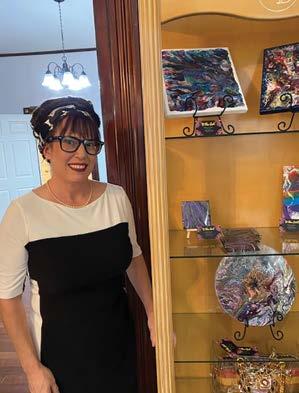
4 minute read
Used in Auto Body Shops ���������������������������

For more than 30 years, collision repair technicians have experimented with glue pulling repair (GPR) techniques to fix vehicles.
The tooling and techniques have improved over the years, allowing an increasing number of auto body shops to adopt GPR in their facilities, according to Chris White, president of KECO Body Repair Products.
“Glue pull repair is rapidly changing how collision repair work is done,” said White. “It is the least invasive, best-quality method to repair a dent today.”
KECO has more than 50 years of experience in plastics. Founded in 1963, the company was purchased by White in 2004. Two years later, it doubled in size and has continued to expand over the years.
In 2018, KECO opened a GPR facility and headquarters for body repair products in Oklahoma City, OK. Today, the team manufactures tabs, tools and accessories and provides training to dent and collision repair technicians.
The company’s Level 2 GPR System was awarded the SEMA 2021 New Product of the Year in Collision & Refinish.
During the SEMA Show, White teamed up with Gene Fetty, KECO’s master technician, to share information about GPR and demonstrate KECO’s products. His presentation, “Glue Pull Repair—Pull to Paint, and Beyond,” was part of the Society of Collision Repair Specialists (SCRS) Repairer Driven Education Series and recorded for future viewing https:// rde.scrs.com.
White explained GPR is a non-invasive cold straightening repair technique to pull dents with plastic tabs in various shapes and sizes. The tabs are adhered to a panel’s clear coat with specialized hot melt glues and then pulled with lifting devices.
“This method of damage removal offers significant advantages over traditional collision repair techniques because it does not remove e-coatings and corrosion protection applied to the panel by the vehicle manufacturer,” noted White. “This yields a simpler, cleaner repair that can significantly reduce the amount of body fillers and/or paint to finish.”
White is currently receiving inquiries from hundreds of shops a month interested in adding GPR to their repair arsenal. “Body work has been done for so long that a lot of guys think there is only one way to fix a dent,” said Derek Heinrichs, manager of City Collision II in Pittsburgh, PA. After experiencing GPR first-hand and physically doing it, Heinrichs said they will continue using this repair method in their body shop.
GPR is Not PDR
Like paintless dent repair (PDR), GPR aims to save as much of the original finish as possible so there’s little to no filling, priming and painting at the end of the repair. In addition, no stud welding is required.
Although GPR is similar to PDR in some ways, White said “GPR is not PDR.”
However, he said, with much more time and skill applied and with many times the use of additional PDR push tools, the GPR process can be a means to a full PDR. GPR is mainly used as a tool for conventional dent repair and enables technicians to avoid disturbing or damaging the insulation and sensitive electronics on the reverse side of the panel.
In addition, he said, technicians experience less damage to the clear coat and less distortion of the metal. This leads to less harmful dust, painting and replacement of panels.
“We’ve found over and over again that panels, particularly aluminum, that needed to be replaced are now repairable,” he said.
A wide range of metals is compatible with GPR, including mild steel, high-strength steel and most aluminum. However, he encourages repairers always to check the OEM procedures.
Chris White, president of KECO Body Repair Products Gene Fetty, KECO’s master technician
The GPR Continuum
White encourages technicians to think of GPR in terms of a continuum—something that keeps changing slowly over time.
“It is that process that can be used very aggressively to move a lot of metal and also a process that can be used with great finesse and detail to be able to move metal and finesse out to a finer finish,” he said.
He shared a graph of a GPR continuum, which includes the types of effort related to the repair, as well as how much filler, glaze, sanding and painting are required.
“Where you want to get to on the continuum is really based first and foremost on the economics of the repair,” explained White.

The GPR Process
Fetty then discussed the GPR process and demonstrated using it on vehicle damage that would have typically needed the panel replaced.
He stressed the importance of following KECO’s “6 Cs” process to have good strong pulls every time.
The 6 Cs: 1. Clean: Always start with a clean panel for maximum adhesion. “Most of the time, all you need is 99% strength isopropyl alcohol,” he said. “Do not use paint thinner or other acetone-based products---anything that can attack the plastic.”
Using a clean towel, follow up with isopropyl alcohol before using glue and tabs on the panel. The last step is to clean with 99% isopropyl alcohol, the glue’s release agent.
2. Check: This involves checking the temperature of the panel, ambient air, tabs and glue; the size of the dent; the type of metal; and where to start pulling.
Fetty said temperature is probably the most overlooked part of a successful repair. “The right temperature will guarantee a strong pull,” he explained. “If the glue is
See Glue Pulling Repair, Page 42


TRUST FORD PARTS
CERTIFIED PARTS WHOLESALING DEALERS
KANSAS Rusty Eck Ford
WICHITA
316-685-9131 316-685-7759 Fax
Hours: M-F 8-5
NEBRASKA Fremont Motors of Scottsbluff
SCOTTSBLUFF
308-635-3701 308-635-4981 Fax
Hours: M-F 7:30-6; Sat 9-3 jlockwood@fremontmotors.com








